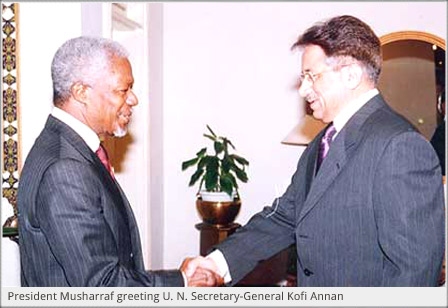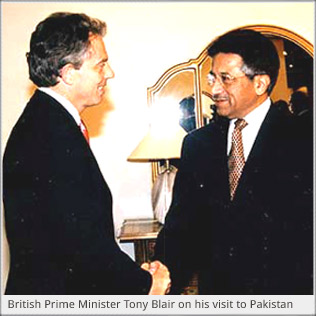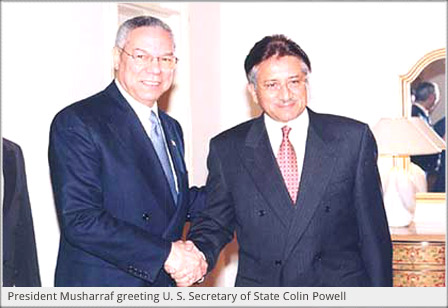On September 11, 2001, with the collapse of the World Trade Center started what the U.S. called “the war against terrorism”. U.S. President George Bush termed it an act of terrorism and threatened strong action against the people who had carried out the attack. It was the Taliban and the Saudi millionaire-turned-militant Osama bin Laden who were eventually held responsible for it. President Bush said that the U.S. would do “whatever it takes” to hunt down “terrorists” and that if Osama bin Laden thought he could hide, “he was mistaken”.
Pakistan became the center of world attention after the September 11 attacks. It was placed in a difficult situation as the U.S. threatened to carry out military strikes on the Taliban. Faced not only with international pressure to take part in curbing the war on terrorism, but also a strong domestic pressure not to side with the United States against an Islamic country, Pakistan sought to assume a delicate balance between the U. S. demands and an expected backlash from internal militant and religious organizations.

General Musharraf made efforts to persuade the country’s political and religious leadership to support an alliance with the United States but was partially successful in his efforts. Liberal-minded politicians agreed to fully back the government while leaders of some hard-line Islamic parties were not happy. Several groups threatened to start a countrywide uprising in protest against any U.S. attack on the Taliban. All the religious parties and various political parties like the Jamiyat-i-Ulema-i-Islam, Jamaat-i-Islami, Pakistan Tehrik-i-Insaaf, shared the same opinion on the possible US military action against the Taliban regime and use of Pakistani soil. They were not only against attacking Afghanistan from Pakistan soil, but were also against offending Pakistan’s closest brotherly neighbor, whom Pakistan had supported against the Soviet Union at the cost of burdening itself with a large number of refugees.
Pakistan was faced with a tough choice and irresistible pressure from the United States, an old ally and sole super power, to support a military strike against Osama bin Laden. That pressure, however, was combined with extreme reluctance to abandon Afghanistan’s ruling Taliban, an old friend and neighbor. Pakistan in this difficult situation was left with actually little choice except to comply with U.S. demands. The Government, despite the protest of the religious parties, decided to cooperate with the U.S. However, it made it very clear that Pakistan would extend full cooperation to the international community in its fight against terrorism without involving its forces in any action beyond its geographical boundaries. The U.S. was given permission to make use of Pakistani airspace for U.S. missile or aerial strikes against targets in Afghanistan. Pakistan also agreed to the exchange of intelligence and logistic facilities and to the closing of Pakistan’s border with Afghanistan.
US attack against the ruling Taliban started almost a month after the September 11 attacks as the Afghan Government refused to meet American demands of closing alleged terrorist training camps, handing over the leaders of the Al-Qaeda network, and return of all foreign nationals, including American citizens detained in Afghanistan.
 As U.S. bombing on Afghanistan started, it was however forecasted on the bases of the Afghan resistance to the Soviets and all previous invaders since Alexander, that the Taliban would never give up their arms. The Americans would have to engage in a long, bloody, guerrilla warfare that would take months, if not years, to yield results. Snow would come and make fighting impossible. Further, sympathetic Muslim sentiment would topple the Musharraf regime and threaten others. It didn’t happen that way; history did not repeat itself. The Americans and their coalition partners carried out extensive aerial bombardment of Afghanistan that led to the killing of large number of innocent civilians and to the takeover of the Taliban strongholds one after another. The Taliban regime was toppled and a transitional government of Taliban opposition was installed in its place.
As U.S. bombing on Afghanistan started, it was however forecasted on the bases of the Afghan resistance to the Soviets and all previous invaders since Alexander, that the Taliban would never give up their arms. The Americans would have to engage in a long, bloody, guerrilla warfare that would take months, if not years, to yield results. Snow would come and make fighting impossible. Further, sympathetic Muslim sentiment would topple the Musharraf regime and threaten others. It didn’t happen that way; history did not repeat itself. The Americans and their coalition partners carried out extensive aerial bombardment of Afghanistan that led to the killing of large number of innocent civilians and to the takeover of the Taliban strongholds one after another. The Taliban regime was toppled and a transitional government of Taliban opposition was installed in its place.
Pakistan was once again faced with the refugee problem in the wake of U.S. military action in Afghanistan. Thousands of Afghans fleeing their country rushed to the Pak-Afghan border. The Government of Pakistan, already bearing the burden of millions of Afghan refugees, deployed additional forces to prevent the entry of displaced people into Pakistan. In spite of the fact that the borders remained closed, some 10,000 people or more crossed at various border points from Afghanistan into Pakistan, further increasing the number of refugees.

After the aerial offense, the ground offensive eventually started to oust the number of Taliban left in Afghanistan. The U.S. continues to focus on tracking down the remaining Al-Qaeda and Taliban leaders in Afghanistan. This means that the U.S. will maintain a significant military force and continue to play a role in the region in the future.
Pakistan once again supported its old ally, the United States, in its military action against Osama bin Laden at the cost of forsaking its old friend and neighbor, the Taliban. But the question whether the American government abandons or continues to support Pakistan after it achieves its objectives still remains to be answered.
This article was last updated on Friday, February 21, 2003






